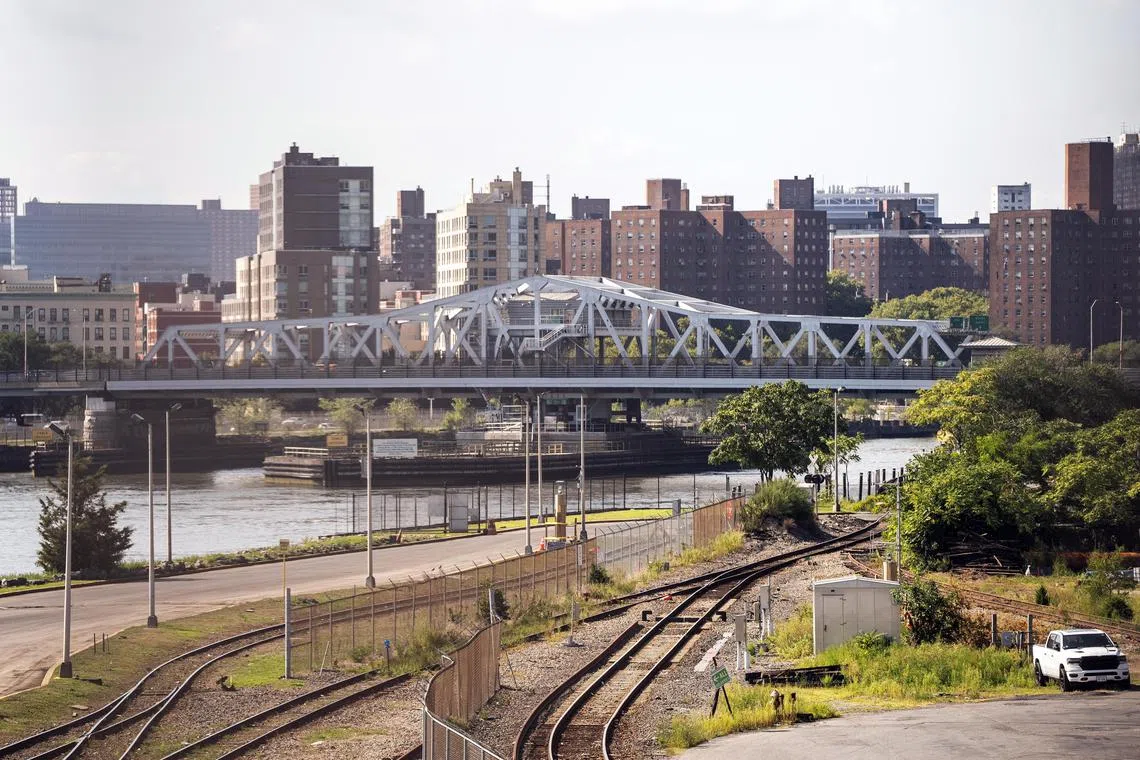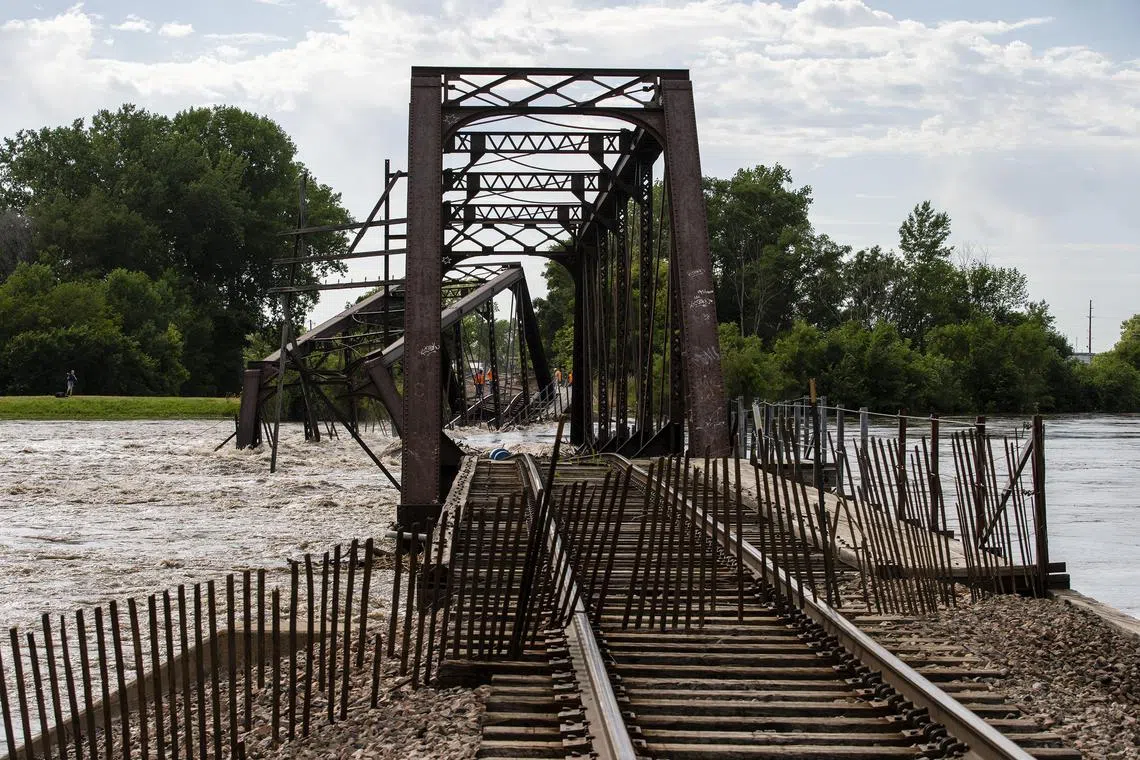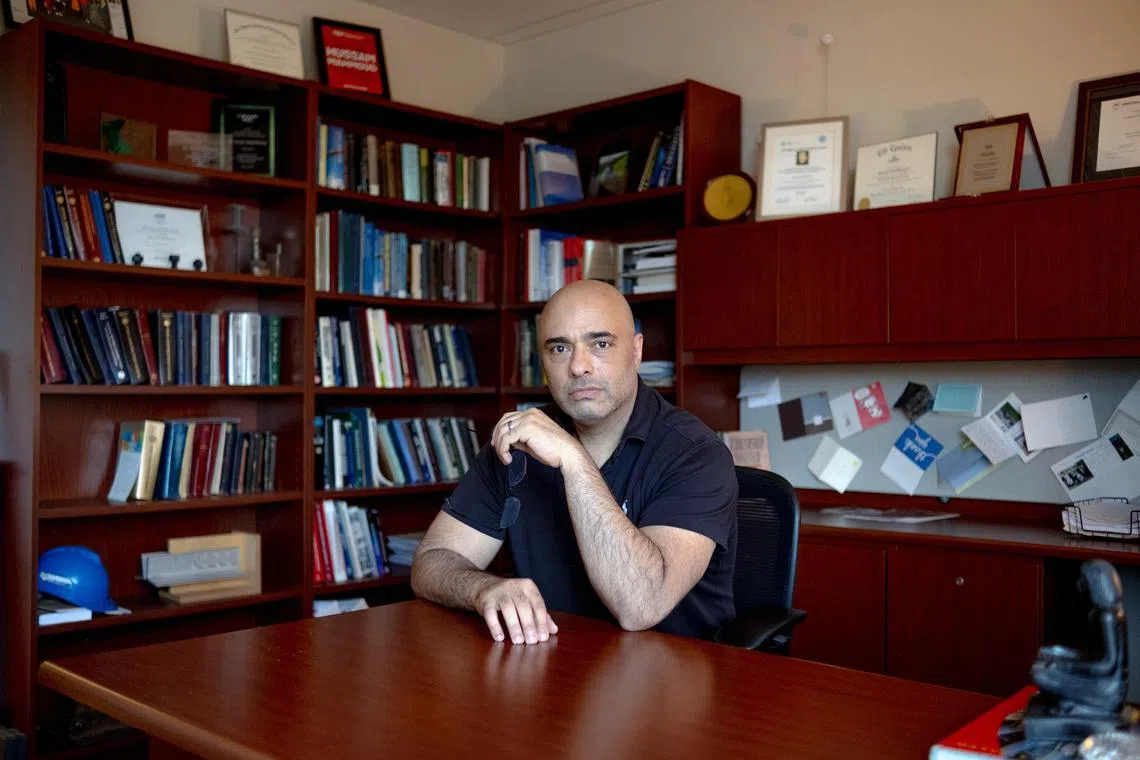Climate change can cause bridges to ‘fall apart like tinkertoys’, experts say
Sign up now: Get ST's newsletters delivered to your inbox

New York City’s Third Avenue Bridge, connecting the Bronx and Manhattan, on Aug 28.
PHOTO: NYTIMES
Follow topic:
NEW YORK – On a 35-deg-C day this summer, New York City’s Third Avenue Bridge, connecting the Bronx and Manhattan, got stuck in the open position for hours.
As heat and flooding scorched and scoured the Midwest, a steel railroad bridge connecting Iowa with South Dakota collapsed under surging waters. In Lewiston, Maine, a bridge closed after the pavement buckled from fluctuating temperatures.
America’s bridges, a quarter of which were built before 1960, were already in need of repair. But now, extreme heat and increased flooding linked to climate change are accelerating the disintegration of the nation’s bridges, engineers say, essentially causing them to age prematurely.
The result is a quiet but growing threat to the safe movement of people and goods around the country, and another example of how climate change is reshaping daily life in ways Americans may not realise.
“We have a bridge crisis that is specifically tied to extreme weather events,” said Paul Chinowsky, a professor of civil engineering at the University of Colorado Boulder who researches the effects of climate change on infrastructure. “These are not things that would happen under normal climate circumstances. These are not things that we’ve ever seen at this rate.”
Bridges designed and built decades ago with materials not intended to withstand sharp temperature swings are now rapidly swelling and contracting, leaving them weakened.
“It’s getting so hot that the pieces that hold the concrete and steel, those bridges can literally fall apart like tinkertoys,” Prof Chinowsky said.
As temperatures reached the highest in recorded history this year, much of the nation’s infrastructure, from highways to runways, has suffered. But bridges face particular risks.
“With bridges, you’re working with infrastructure that may have been planned, designed and built decades ago,” Transportation Secretary Pete Buttigieg said in an interview. “It’s one of the forms of infrastructure that takes the longest to update or refresh. And yet we’re seeing those vulnerabilities everywhere across the country.”
A study in the journal Plos One found that extreme temperatures resulting from climate change could cause 1 in 4 steel bridges in the United States to collapse by 2050. By 2040, failures caused by extreme heat could require widespread bridge repairs and closures, researchers found.
Another study found that exposure to new levels of extreme heat is causing the pavement on American bridges to buckle. Meanwhile, heavy precipitation linked to climate change is increasing the phenomenon of “bridge scour”, the erosion of soil sediment around bridge foundations that is the leading cause of bridge failure in the US, studies show.
Troubled bridges are starting to affect supply chains and the cost of goods.
In 2022, a 9m section of bridge on the California-Arizona border of Interstate 10, along a major trucking route from Phoenix to the port of Los Angeles, was swept away during record rainfall. That washout followed a 2015 collapse of another Interstate 10 span, the Tex Wash Bridge, during what was described at the time as a 1,000-year flood.

As heat and flooding scorched and scoured the Midwest, a steel railroad bridge connecting Iowa with South Dakota collapsed under surging waters
PHOTO: NYTIMES
Each closure added an estimated US$2.5 million (S$3.3 million) per day to trucking costs because of delays and additional fuel, according to the American Transportation Research Institute. Such bridge closures are projected to increase significantly nationwide over the coming decade, engineers said.
“With a lot of these bridge closures, trucks have to reroute far more than normal. It adds anywhere from 15 to 100 miles per trip, when a trucking trip typically costs about US$91 per hour,” said Mr Dan Murray, senior vice-president of the American Transportation Research Institute. “And it becomes very inflationary. We’re buying the same goods and the unexpected costs get passed on to consumers.”
Mr Bill Minor, 50, a Walmart truck driver who delivers groceries, clothing and electronics from a terminal in Beaver Dam, Wisconsin, to stores in the surrounding region, said he crosses the Lake Butte des Morts Bridge in Oshkosh, Wisconsin, as many as a dozen times a day. When it closed for a day in June after heat caused a joint in the approach to the bridge to expand, Mr Minor said that the added detour and traffic meant that he made fewer deliveries and used more fuel.
“The bridge is on an interstate but the detour is country highways, so you’re driving through little towns going 25 miles an hour,” he said.
The Biden administration has sought to address the problem. The 2021 bipartisan infrastructure law allotted US$110 billion for repair and construction of roads, bridges and other major transportation projects. The law included a pioneering program, Protect, that provides US$7.3 billion divided among states to make facilities and highways more resilient to extreme weather. Another US$1.4 billion in competitive grants is also available.
In Vermont, where heavy rainfall and heat have combined to damage an estimated 100 bridges over the past two years, the state is rebuilding them higher and wider, with deeper foundations and sturdier materials. And waterways below bridges are being made deeper and wider to be able to absorb more water.
But that all takes money and time. It is costing Vermont 30 per cent to 40 per cent more to build a more flood-resistant bridge, said Mr Jeremy Reed, chief engineer at the state transportation agency.
Scientists, engineers and government agencies are only now beginning to develop standards for how to build climate-resilient bridges, said Mr Jim Tymon, executive director of the American Association of State Highway and Transportation Officials. “We’re learning from the events that are being thrown at us, and trying to change and build for what climate change throws next, but it’s a moving target,” he said.
In 2018, Colorado became one of the first states to consider the effects of climate change as it planned its roads and bridges. After a 2013 flood damaged roughly 800km of road and 50 bridges in the state, requiring more than US$700 million in emergency repairs, the state transportation commission required climate resilience in bridge and road construction.
The state asked Professor Hussam Mahmoud, a civil engineer and professor at Colorado State University, to examine increased deterioration and stress in the joints of the state’s steel bridges. “What we saw was drastic,” Prof Mahmoud said.

Professor Hussam Mahmoud said that because of extreme spikes in heat linked to climate change, the joints of bridges were swelling more frequently.
PHOTO: NYTIMES
For decades, bridge surfaces have been zippered together with fork-teethed expansion joints, embedded into steel and pavement to accommodate normal swelling and contraction with heat and cold.
But because of extreme spikes in heat linked to climate change, the joints were swelling more, and more frequently, said Prof Mahmoud. The problem worsened as overheated joints expanded tightly around the highway debris that typically collects between them. “Once this happens, the bridge can become permanently damaged,” he said. “The steel deforms and twists, the deck cracks, and moisture goes through it and it causes corrosion.”
Swollen joints cause other problems. Steel bridges are designed to gently bend to accommodate heavy loads, but clogged joints keep beams stiff, failing to spread out the load from large trucks.
“That means the beams in the bridge are carrying much more weight than they were designed for,” Prof Mahmoud said.
Age is usually one of the best predictors of bridge fragility. Engineers generally prioritise bridges for repair and replacement once they are past 50 years old.
So Prof Mahmoud was surprised to find that some Colorado bridges in the worst shape included an 18-year-old-bridge over Riverside Canal in Morgan County, a 29-year old bridge on County Road 501 through Pueblo County, and a 10-year-old bridge on County Road 17 over the Otero Canal in Otero County.
All of these bridges were deemed in “good” or “satisfactory” condition by the Federal Highway Administration’s National Bridge Inventory based on inspections between 2020 and 2022.
Colorado transportation officials say that, while they now take such research into account as they prioritise what bridges to repair, the state does not have the funding for all those improvements. Under the infrastructure law, the state receives US$45 million a year in federal funds for bridge repair and is getting US$98 million a year from the Protect program to help make all of its infrastructure more climate resilient, both through 2026.
State officials estimate that Colorado probably needs more than five times as much annually. “Realistically, we know that’s not going to happen,” said William Johnson, who leads climate resilience programs for the Colorado Department of Transportation. “We can’t replace everything tomorrow to be more resilient, but we are building climate change into the process.”
Mahmoud expanded his research across the country, using details from the National Bridge Inventory to model the impact of climate change on the beams, decks and girders of 80,000 steel bridges. He found the bridges most at risk were in the Northern Rockies and Plains, the upper Midwest, the Ohio Valley and the South. He also found that smaller bridges, with smaller beams, were more vulnerable to damage, since they are made to accommodate lighter loads.
The bridges in Prof Mahmoud’s database include 1,357 steel bridges in Oklahoma and 575 bridges in North Dakota, among them a 25-year-old bridge over the North Branch Goose River in Traill County, North Dakota, a 16-year-old bridge on a county highway through Grand Forks County, North Dakota, and an 11-year-old bridge on E0220 road in Grant County, Oklahoma.
“These bridges in these states were designed according to code,” Prof Mahmoud said. But because of the unplanned damage induced by climate change, he said, “we will see the beams on these bridges twisting, concrete coming off, and bridges closing.”
Jason Thorenson, the North Dakota state bridge engineer, said he did not agree that the North Dakota bridges cited by Mahmoud are at risk. The state receives about $45 million a year from the PROTECT program, he said, “but I wouldn’t say we use that money to address any sort of climate change, because I can’t say we’re really seeing that.”
Tim Gatz, deputy director of the Oklahoma Department of Transportation, said cold as well as heat can stress roads and bridges. “We have always had a very wide range of weather conditions,” he said. “Sometimes extreme cold and sometimes extreme heat.”
Studies show that climate change has caused more rapid shifts between extreme heat and cold, said Royce Floyd, a professor of engineering at the University of Oklahoma. Those seesawing temperatures can cause pavement to squeeze from both sides onto a span, forcing the road and steel to buckle or crack, or even pushing steel beams out of alignment, Prof Floyd found.
That’s what happened to at least three major bridges in Oklahoma in recent years, he said. The bridges have since been repaired – without taking into account studies that show the current and future impacts of climate change. But failing to make them hardier means that the buckling could return, Prof Floyd said.
“If you don’t plan for climate change then you’re going to end up with the same problems again,” he said. NYTIMES

